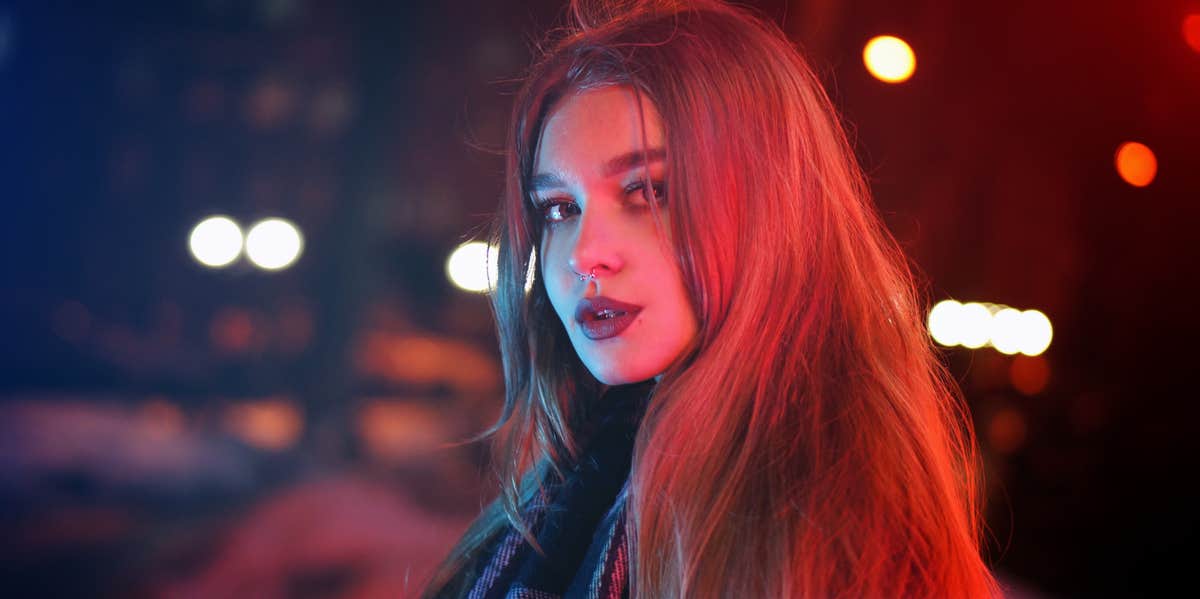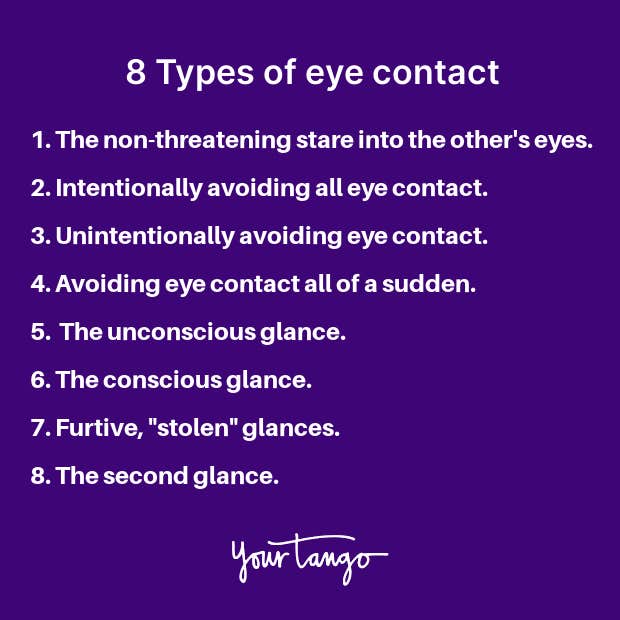What 8 Types Of Eye Contact Mean When It Comes To Attraction
Eyes may tell everything about how someone feels, but what are they really saying?
 Ilya Morozov / Shutterstock
Ilya Morozov / Shutterstock Different types of eye contact have a way of telling it all, especially when it comes to someone's level of attraction. That's why there are rules for decoding how someone really feels when your eyes meet theirs.
One of the best ways to communicate with someone is by maintaining eye contact during conversation, as eyes are the windows to the soul. After all, they won't be able to hide what they aren't saying with their words behind what their eyes are spelling out right in front of you.
Eye Contact and Attraction
Using eye contact is one of the best ways to convey your interest in what someone else and what they're saying.
This is essential at the start of relationships, as establishing prolonged eye contact is an easy way for you to connect more deeply to the person you're attracted to, even if it's not love at first sight.
Making eye contact with your romantic interest or even someone you're simply trying to understand better is an immediate way to get an idea of how they're feeling. It's near impossible to hide one's attraction, no matter how many coats of mascara one uses in an attempt to veil their gaze.
If your date is holding eye contact for extended periods of time, you can hedge your bets by assuming they are most likely attracted to you and are getting to know you better romantically.
Keep in mind that it's just as important to pay close attention to one's eye contact along with their words and the rest of their body language, but be careful — messages conveyed through eye contact can often be misinterpreted.
If you can become well-versed in the language of the eyes, you will already be a step or two ahead of all your potential partners, in romance — even business.
Reading someone's eyes is as critical as reading the room, so it should go without saying: picking up on different types of eye contact is one of the best skills you can learn to succeed in all areas of life.
8 Different Types and Levels of Eye Contact
1. Non-threatening stare
This type of staring is the good type, where you're intently focusing on someone's eyes, and not in a creepy way. Staring at someone could show that you're attracted to them but you might be afraid to admit it.
However, staring can be tricky; if you stare at someone for too long, it can come across as confrontational, invasive, and, at the very least, make them uncomfortable.
Staring softly into someone else's eyes for an appropriately prolonged level of time can show that you're romantically attracted to someone, especially when focusing on their eyes or laps and accompanying it with a slight smile. You can further disarm them with what's known as a Duchenne Smile, or more colloquially, "smizing."
2. Intentionally avoiding eye contact
This type of eye contact, as you might have guessed, involves purposefully trying as much as humanly possible to avert meeting eyes with someone else. This lack of eye contact can be a signal that someone is attracted to you but is very shy and anxious to give in and establish eye contact with you.
However, this type of eye contact can only be determined if you're already somewhat clued into what could be behind these missed connections, such as if someone had already told you that this person was into you.
This type of eye contact could also demonstrate, either from a stranger or someone you know well, that they don't want to talk to you, they aren't interested, or perhaps they have social anxiety.
3. Unintentionally avoiding eye contact
This form of eye contact (or lack thereof) could mean any number of reasons, but it's safe to say it's rarely directed in any negative way toward you — or that it has anything to do with you at all.
The person might simply be looking around absent-mindedly and are unaware of you individually — not necessarily because you don't stand out but because they're preoccupied or otherwise not actually paying attention to the people around them in any emotionally-attuned way.
They could also be subconsciously preoccupied with issues of their own, such as a fight they had with someone earlier that morning. They may have a habit of avoiding others' eyes, due to trauma that has seriously impacted their ability to connect with others.
They could also have behavior associated with a specific attachment style or otherwise be impacted by another mental health-related matter.
4. Avoiding eye contact suddenly
This lack of eye contact is more concerning because it most likely has something to do with your relationship with that person, even if you barely know each other.
In a more innocent example, let's say you went out on a date and now they feel embarrassed about something they said or did, particularly if they're not used to being vulnerable or aren't ready to face the idea of a romantic connection.
In other cases, they could be harboring negative emotions, like anger or pent-up resentment toward you, but they don't want to confront you about it yet (or, at least, in the present, surrounding environment).
Regardless of the situation, consider the context and try using your intuition to know whether it would be best to gently break the silence and ask if everything is OK, or if it would be best to keep your distance until they're ready to approach you. (Chances are, you can bet on the latter.)

5. The unconscious glance
Similar to unintentionally avoiding eye contact, the unconscious glance usually comes from a place of being aloof, disinterested in whatever's going on, and distractedly scanning the room.
Maybe this person is sitting in yet another hour-long meeting that could have been summed up in an email, and they're bored out of their minds, letting their mind wander. Perhaps they're the presenter and are trying to connect with their audience by making eye contact with them.
Or, as in most instances, it could have been a complete accident. Either way, it's usually harmless and not intended to communicate anything, one way or the other.
6. The conscious glance
This is probably one of the most common types of eye contact when strangers are trying to establish a connection with one another, especially in the case of building attraction — a "spark" — between them.
You might elbow your way through a crowd to subtly stand in close proximity to a person you're interested in. You begin by testing out the unconscious glance, "accidentally" catching their gaze, then holding it for a beat (not a moment longer) while flashing a friendly smile to see if they notice and gauge whether they might be open to chatting.
You can usually tell if they are attracted to you if they respond to your glance and mirror your body language, turning toward you and sending a smile back.
7. Furtive, 'stolen' glances
Furtive glances are when a person who likes you takes a look at you to register what you look like and then looks away before you catch them staring. This is because the person might be attracted to you but they're too shy to let you know.
They can't help but keep darting their eyes back at you, as they're drawn to you. If you catch on and are able to lock eyes for even just a second, it can feel electrifying if that lightning bolt of mutual attraction strikes.
8. The second glance
This type of eye gaze can go in very separate ways, so you have to use your judgment carefully.
Often, this occurs when you happen to notice someone who was already looking at you intently, then briefly lock eyes before they suddenly avert theirs, usually by looking down, then back up at you again.
This is like the double-take of eye contact, as they clearly find you attractive and want to establish some chemistry and build the attraction they feel.
Alternatively, this person might consciously or unconsciously be gravitating toward you, simply because they find you interesting but don't want to seem rude. While they might be curious about you, they don't want to send the wrong message.
It's critical that, whenever you're trying to assess the situation when it comes to different types of contact and what they mean, you need to be sensitive to the fact that the meaning behind their direct gaze or avoidant gaze could be influenced by any number of differential factors, such as their family or cultural background being different from the contextual conventions you were raised in.
One thing about eye contact, however, is that it is naturally influenced by our human intuition, regardless of when or where we grew up. While it is still an art, the trick to understanding the meaning behind different types of eye contact and how they relate to attraction isn't so mysterious after all.
Megan Hatch is a former contributor to YourTango who has had bylines on Medium, Buzzfeed, MSN Canada, Patch, Voice of America, Canyon News, and others.
